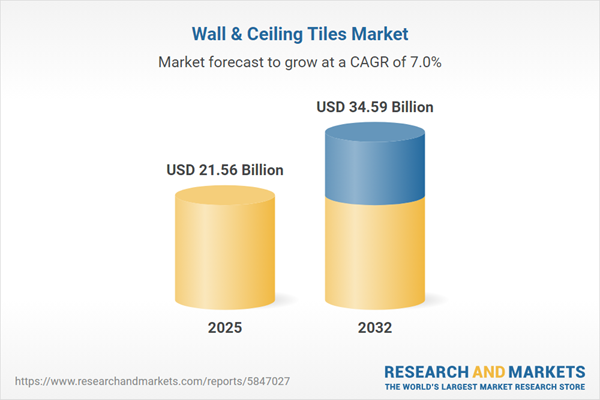Speak directly to the analyst to clarify any post sales queries you may have.
The wall and ceiling tiles market is advancing rapidly, driven by changes in design priorities, updated regulatory frameworks, and increasingly sophisticated procurement demands across commercial and architectural sectors. Senior executives require relevant, actionable insights to adapt to this evolving market environment and build resilient strategies.
Market Snapshot: Wall & Ceiling Tiles Market Overview
The global wall and ceiling tiles market is set to reach a value of USD 20.17 billion in 2024, reflecting a compound annual growth rate of 6.97%. This growth is propelled by stronger investments in technical tile surface enhancements, tighter alignment with compliance requirements, and an increased focus on modular installation approaches. Industry leaders are emphasizing adaptable design solutions for both commercial and residential spaces. The competitive landscape is marked by shifting regulations and a strategic emphasis on operational efficiency. Ongoing innovation continuously fuels the rollout of advanced, value-driven product lines aligned with evolving project demands.
Scope & Segmentation of the Wall and Ceiling Tiles Market
- Material Types: Ceramic, glass, metal, porcelain, granite, marble, slate, and natural stone enable diverse project specifications through their durability and design versatility, supporting a wide range of technical and aesthetic applications.
- Product Types: Wall and ceiling tiles address both visual enhancement and acoustic requirements, meeting the needs of public, commercial, and specialized environments where design and functionality must co-exist.
- End Use Applications: Commercial, healthcare, hospitality, office, residential, and institutional projects leverage these materials to address operational standards and functional expectations within each sector.
- Distribution Channels: Flexible sourcing through offline suppliers, specialty retailers, e-commerce, contractors, and third-party distributors ensures responsive procurement and efficient project fulfillment.
- Application Settings: Solutions are designed for both interior and exterior environments, delivering resilience to variable exposure conditions and supporting adaptive project outcomes.
- Size Specifications: Choices span from large-format panels that suit expansive, open areas to compact tiles crafted for precise installations and customized design features.
- Installation Methods: Dry methods quicken the installation process and reduce labor intensity, while traditional wet-set techniques enable robust, customized finishes in demanding project scenarios.
- Geographical Coverage: Key regions include North America, Latin America, Europe, Middle East & Africa, and Asia-Pacific, each offering unique regulatory challenges and market opportunities. Adaptive local strategies and strong partnerships support market penetration across these geographies.
- Leading Market Players: Organizations such as Mohawk Industries, Grupo Lamosa, RAK Ceramics, Kajaria Ceramics, SCG Ceramics, Somany Ceramics, Florim Ceramiche, Pamesa Cerámica, Interceramic, and Iris Ceramica maintain robust competitive positions and drive innovation within the sector.
Key Takeaways for Senior Decision-Makers
- Sustainability is a critical driver, prompting industry adoption of recycled materials and energy-efficient production processes to satisfy growing client and regulatory expectations.
- Innovative digital printing and acoustic technologies allow manufacturers to target specialized and technically demanding installations, increasing project relevance and responsiveness.
- Broadened supplier and distribution networks across markets and channels enhance reliability and mitigate the impact of shifts in global trade dynamics.
- Automation and digital tools in manufacturing support agile adaptation and enable faster turnaround times, supporting greater design customization for both standard and unique projects.
- Strong collaboration among suppliers, construction partners, and project management teams underpins timely delivery, elevated quality benchmarks, and the functionality of completed spaces.
- Diversified partnership and investment approaches enable organizations to navigate complex project requirements while maintaining operational flexibility in changing market conditions.
Tariff Impact on Cost and Sourcing Strategies
Tariffs on core input materials, such as ceramic, glass, metal, and natural stone, require organizations to update sourcing practices. By developing local and regional supplier networks and focusing on modular tile solutions, companies reduce risks related to cost fluctuations and ensure project continuity. A flexible procurement approach is fundamental for managing supply volatility and maintaining operational efficiency.
Methodology & Data Sources
This market analysis is based on executive interviews, contributions from strategic partners, industry research, technical evaluations, and direct on-site assessments. This comprehensive methodology ensures the findings are credible and tightly aligned with executive-level decision-making needs.
Why This Report Matters
- Equips senior executives with focused market analysis to guide innovation and decision-making within construction and architectural supply chains.
- Supplies clear insights on regulatory and technology trends, supporting efficient supply chain optimization and readiness for evolving requirements.
- Enables strategic investment, market entry, or expansion decisions with precise, segment-specific intelligence.
Conclusion
Senior decision-makers can achieve a resilient market position by embedding timely intelligence, strengthening their sustainability agenda, and fostering high-value partnerships within the evolving wall and ceiling tiles market.
Additional Product Information:
- Purchase of this report includes 1 year online access with quarterly updates.
- This report can be updated on request. Please contact our Customer Experience team using the Ask a Question widget on our website.
Table of Contents
3. Executive Summary
4. Market Overview
7. Cumulative Impact of Artificial Intelligence 2025
Companies Mentioned
The companies profiled in this Wall & Ceiling Tiles market report include:- Mohawk Industries, Inc.
- Grupo Lamosa, S.A.B. de C.V.
- RAK Ceramics P.J.S.C.
- Kajaria Ceramics Ltd.
- SCG Ceramics Co., Ltd.
- Somany Ceramics Ltd.
- Florim Ceramiche S.p.A.
- Pamesa Cerámica S.A.
- Interceramic, S.A. de C.V.
- Iris Ceramica S.p.A.
Table Information
| Report Attribute | Details |
|---|---|
| No. of Pages | 183 |
| Published | October 2025 |
| Forecast Period | 2025 - 2032 |
| Estimated Market Value ( USD | $ 21.56 Billion |
| Forecasted Market Value ( USD | $ 34.59 Billion |
| Compound Annual Growth Rate | 6.9% |
| Regions Covered | Global |
| No. of Companies Mentioned | 11 |









